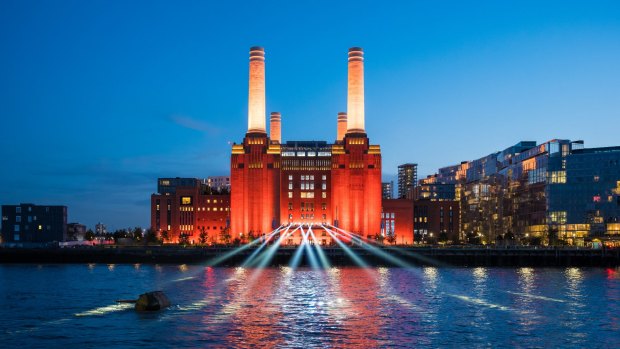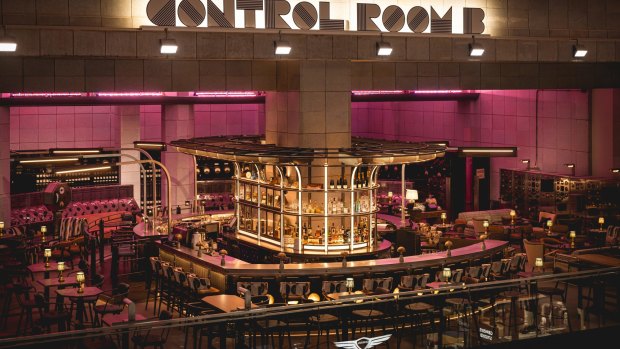This was published 1 year ago
Battersea Power Station: The art deco monolith set to be London's flashiest shopping mall
By Sue Williams

Battersea Power Station, the hulking great 1930s brick monster which used to supply electricity to Buckingham Palace, the House of Commons and a fifth of the rest of the city.Credit: Battersea Power Station
It's London's newest old attraction – the restored and repurposed Battersea Power Station, the hulking great 1930s brick monster which used to supply electricity to Buckingham Palace, the House of Commons and a fifth of the rest of the city.
Forty years ago, after half a century in operation, it was decommissioned and left to slowly disintegrate while politicians, public servants and planners argued over what should be done with it.
And now, finally, the Grade II-listed art deco monolith has risen again like a phoenix from the coal ashes … reborn as part of a £9 billion development as the capital's flashiest shopping mall, entertainment hub, office complex and its latest hip place to stay, and live.

One of the best bars is the atmospheric 1950s all-day affair in the station's historic Control Room B.Credit: Battersea Power Station
Officially opened last October the transformation is astonishing. I moved to the south London suburb of Battersea in 1983 when the building was first shut down, barricaded behind high wire fences and abandoned while the authorities thrashed out ideas of theme parks, Chelsea's new football stadium, a sports centre, an aeronautical museum, a mosque. There was even a plan dubbed the "Bat Hat", where the fab four tall white towers would stand on columns with public thoroughfares underneath. Another plan was to simply tear it all down and start again.
Meanwhile, every day I walked past, it looked more and more forlorn. Bricks fell, the roof caved in, tumbleweeds gathered, the wire rusted. It felt like no way to treat a national treasure.
Today, however, it's back as a gleaming icon of pride for London, and every visitor should put it on their must-see list as both an absorbing insight into the city's past and a thrilling glimpse of what's possible.
With the redesign helmed by architects WilkinsonEyre – the same company which brought that other distinctive landmark Crown Sydney to Barangaroo (and will later give Melbourne's Southbank One Queensbridge) – it's now a mixed-use project but with that over-arching heritage anchor.
You reach the vast 17-hectare site via a new extension of the Tube's Northern Line from which you walk, via the pedestrianised high street Electric Boulevard, to the power station. Either side are an array of new apartments, some crumpled-looking ones by Gehry Partners, a la the UTS's Dr Chau Chak Wing building, and others in the form of a sleek curved wall by Fosters + Partners, whose work is equally well known here.
When the power station reveals itself, the sight is breathtaking. So well-known from a distance, and as the backdrop for movies like The Dark Knight, Fast & Furious and Superman III, as well as on the cover of Pink Floyd's 1977 album, Animals, close-up, it's simply gobsmacking.
One of the largest brick buildings in Europe, it is made of 6 million bricks with 1.75 million more ordered from the original brick-makers for the eight-year restoration, with the towers dismantled and rebuilt, its size is quite overwhelming. St Paul's Cathedral, for instance, could fit comfortably inside its boiler house.
The dramatically cavernous interiors are complete with plenty of original features like remnants of old staircases, a gantry crane that once lowered coal into the turbines and (reinforced) girders. But now they're also packed with over 100 stores, from Ralph Lauren to Uniqlo, with a boxing gym, cinema, 254 apartments, 48,000 square metres of office space, the UK's first art'otel, restaurants and bars.
One of the best bars is the atmospheric 1950s all-day affair in the station's historic Control Room B as part of the building added back then when more power was needed, while Control Room A has been opened, with its old technology and restored switchboards, as a funky events space.
In Turbine Hall A, there's an exhibition of the building's history with multi-media displays evoking the heat and explosions of energy generated on the site. From there, Lift 109 provides a ride up the northwest chimney to a 109-metre-high platform with stunning 360-degree views over London.
Next to come are a 450-metre river frontage, with riverside restaurants and cafes, a food hall, a 2.4 hectare public park, a brewery and, eventually 25,000 people living and working in the new community.
The power station was re-opened late last year and, over that first weekend, 250,000 people flooded in to see the old girl in her new glory. And to marvel over the triumph of hope and vision that inspires us all to pay respects to the past, while gazing firmly at the future.
THE DETAILS
RAIL
Take the underground to new Battersea Power Station stop at the end of the Northern Line. See tfl.gov.uk/modes/tube/
SEE
MORE
The writer was a guest of Battersea Power Station
Sign up for the Traveller Deals newsletter
Get exclusive travel deals delivered straight to your inbox. Sign up now.